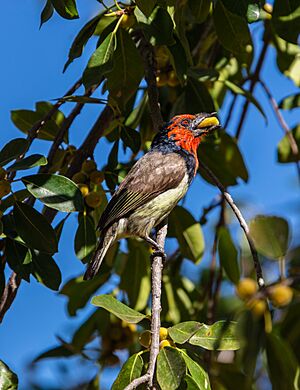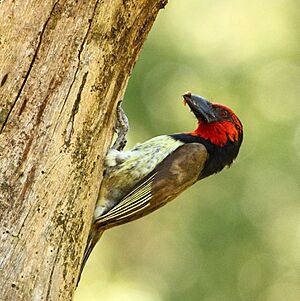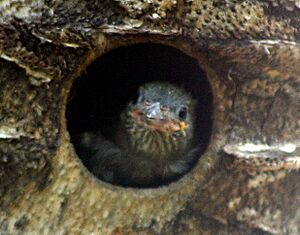Black-collared barbet facts for kids
Quick facts for kids Black-collared barbet |
|
|---|---|
 |
|
| Conservation status | |
| Scientific classification | |
| Genus: |
Lybius
|
| Species: |
torquatus
|
The black-collared barbet (Lybius torquatus) is a colorful bird found in sub-Saharan Africa. It belongs to the Lybiidae family, which includes many types of barbets. People in Africa have different names for this bird. For example, it's called Rooikophoutkapper in Afrikaans. In Zulu, it's known as isiKhulukhulu or isiQonQotho. The Xhosa people call it Isinagogo.
Contents
Where They Live
These birds live in many parts of Sub-Saharan Africa. You can find them in countries like Angola, Botswana, and South Africa. They also live in Kenya, Tanzania, and Uganda. Their home stretches across Zambia, Zimbabwe, and even Eswatini.
What They Look Like
The black-collared barbet is a medium-sized bird. It usually grows to be about 20 to 25 centimeters long. These birds look quite plump and have a big head. They also have a strong, thick beak with bristles around it.
Their name comes from the clear black collar around their neck. Their head is also black. A bright, fiery red color surrounds their eyes and beak. Sometimes, a barbet might have a red head instead of a black one. This is a natural color variation. Both male and female barbets look very similar.
Their Special Calls
Black-collared barbets are known for their loud calls. They often sing in a duet, which means two birds sing together. You won't usually hear one of these birds singing by itself. Their duet sounds like "too-puddly too-puddly" or "too-doodle too-doodle".
When they sing, the birds face each other. They lean forward and bow as they call. One bird starts the song, and the other quickly joins in. It happens so fast that it sounds like one bird singing! They also make a snarling warning call and a loud buzzing sound.
These birds also use their wings a lot when they communicate. They flick their wings during their calls. They also use wing displays during greetings, mating, and when defending their territory. Black-collared barbets are social birds. They often work together to chase away other birds. Up to 15 barbets have been seen roosting, or resting, together in nest holes.
What They Eat
Black-collared barbets mostly live alone. They enjoy eating many different kinds of fruits and vegetables. You might see them visiting fruit farms to find food. They swallow fruits whole and later spit out the seeds.
Sometimes, these barbets also eat insects. They can even snack on centipedes, lizards, frogs, and geckos. However, fruits are their main food.
Breeding Season
Black-collared barbets have their breeding season from December to February. This is when they lay their eggs and raise their young.
Types of Black-collared Barbets
There are several types, or subspecies, of the black-collared barbet. They are all part of the Lybius torquatus species. Some of these include:
- L. t. zombae
- L. t. pumilio
- L. t. irroratus
- L. t. congicus
- L. t. vivacens – found in Malawi, Mozambique, and eastern Zimbabwe.
- L. t. bocagei – found in Angola, western Zambia, northern Namibia, and northern Botswana.
- L. t. torquatus – found in the southernmost areas, from eastern Botswana to Eswatini and the Eastern Cape.





